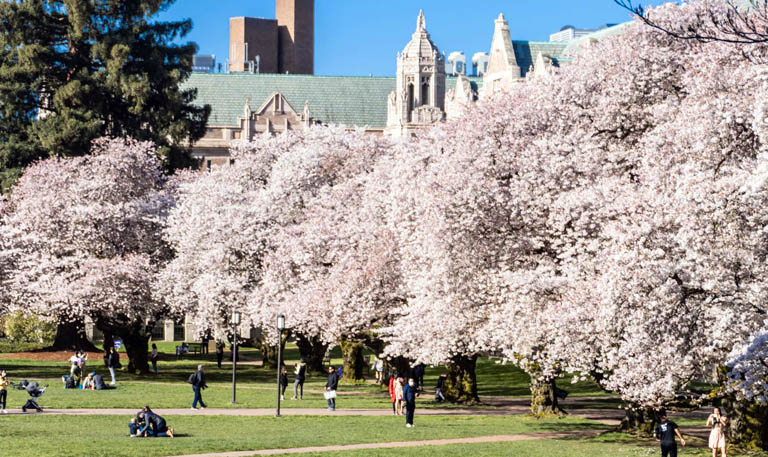By MARGOT KRAVETTE
I’d never been to the (Seattle) Arboretum this early in the year, but it was worth a try. What I found was like the earth giving birth everywhere I turned. I’m not sure if this was coincidental or an act of a higher force, but the day I visited the Arboretum was the same day my daughter gave birth to my newest grandchild. —Margot Kravette, “Looking for Spring in the Arboretum” (March 20, 2021)
Spring is glorious in Western Washington. Days are longer. The temperature is not too cold or too warm. Hints of color start whispering through leaves and grass after a season of grey and rain. Birds, returning from their southern winter vacations, fill the air with song. The feel of the warm sun reflecting on our skin brings joy. It’s energizing just to be outside. Spring is, without a doubt, one of the best times of the year to explore Washington’s beautiful public gardens. Here are some I recommend:
Washington Park Arboretum
The Washington Park Arboretum in Seattle has 230 acres of woodlands, wetlands, gardens, and walking trails. With more than 40,000 plants and trees, it is one of the most diverse and important plant collections in North America. I was not prepared for the many colorful displays when I visited so early in spring. Buds were abundant and some of the early bloomers—camellias, magnolias, and rhododendrons—were out in force. There was just enough blooming to hint that within a few short weeks, the Arboretum would explode with color.
Washington State Capital Campus
Many people are not aware that the Washington State Capital Campus in Olympia is so much more than just a single building. It is one of the most beautiful public gardens in Western Washington. In addition to multiple governmental buildings, it boasts manicured gardens, green zones, ponds, fountains, parks, trails, and 18 major art installations—many recognizing important historic events in our state along with national history. The campus website includes helpful resources on visiting and tours. For example, you can find a list of all of the different types of trees along with a map of where to find them. There is so much to discover there.
Point Defiance Park
I always associated Point Defiance Park with its zoo and aquarium. But that’s not all there is. The 700+ acre park has multiple gardens including the Rose, Lilly, Fuchsia, and Dahlia Gardens, the Rhododendron Garden, and the Japanese Garden. The early bloomers in the Rhododendron Garden were just starting to come in when I visited in late March. The vibrant rain-fed moss and ferns on and around the trees look like hand-woven lace in open, web-like patterns. There are walking paths and hiking trails to explore, the Owen Park Beach, and the Fort Nisqually Living History Museum. A five-mile, one-way drive weaves its way through the park’s soaring old-growth trees—a reminder that they have been around a lot longer than we have.
University of Washington Campus
A springtime year-after-year favorite is seeing the University of Washington cherry blossoms at their peak. Strolling through campus you’ll know you’ve reached the right place when you are suddenly struck with an explosion of soft pink blossoms and bright green grass. UW’s 30 Yoshino cherry trees are in peak bloom for two weeks in March. Many visitors are Japanese, whose culture has long celebrated cherry blossoms—known as Sakura—as they are a symbol of renewal.
Bloedel Nature Preserve
Long before the Bloedel Reserve was created, the Suquamish People—People of the Clear Water—sustained the land for thousands of years. Virginia and Prentice Bloedel purchased the land in 1951, and Prentice spent much of his 30 years there sculpting the land—later donating it to the community and establishing a nonprofit to support its ongoing operation. The long path through a vast meadow begins a meandering walk through formal gardens, woodlands, ponds, and extensive scenery. Together they create a medley of landscape experiences—a tribute to beauty and nature that elicits marvel, curiosity, admiration, and awe.
Harriet Ann Jacobs, a writer and abolitionist in the 1800s, said in her autobiography, “The beautiful spring came, and when nature resumes her loveliness, the human soul is apt to revive also.”
I wholeheartedly agree.
Margot Kravette is a retired healthcare leader whose longtime hobby has been travel photography. She has captured creative images around the U.S. and abroad. Her most recent work can be found at https://InspiredJourneys.live. Her photos are also on display at three King County, Wash., bus shelters.
More spring adventures await! See below:
The Bloedel Reserve: An Ancient Land Offers Fresh Inspiration


